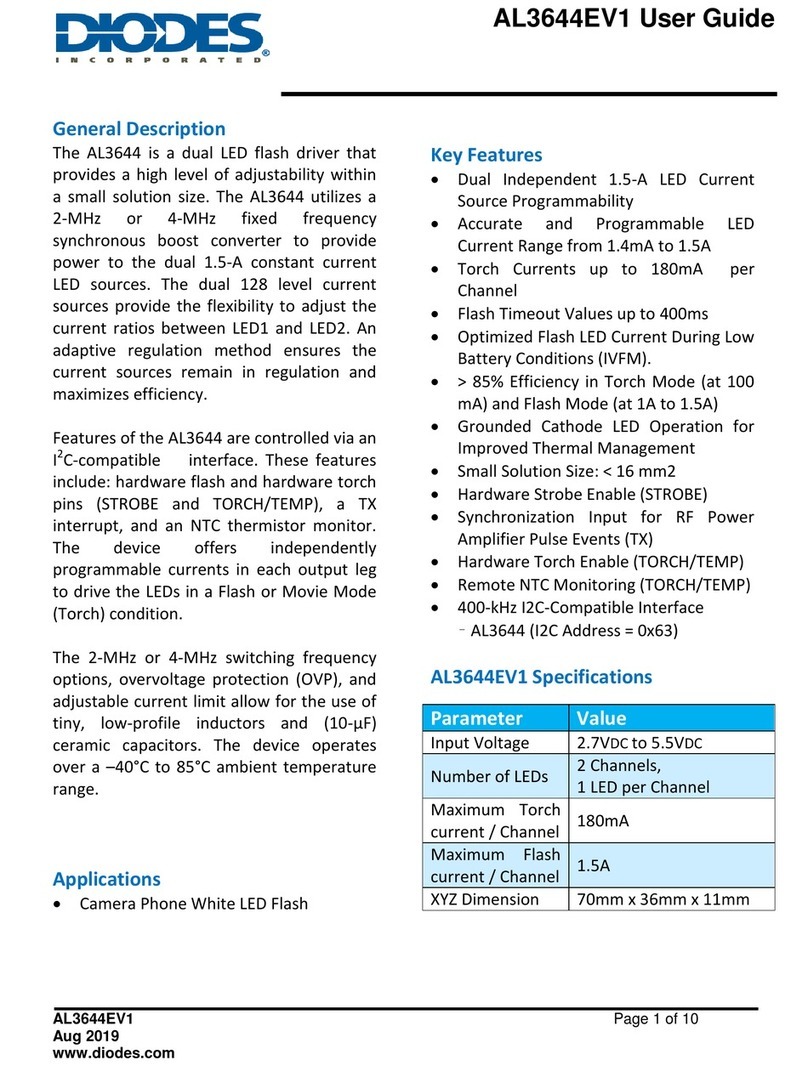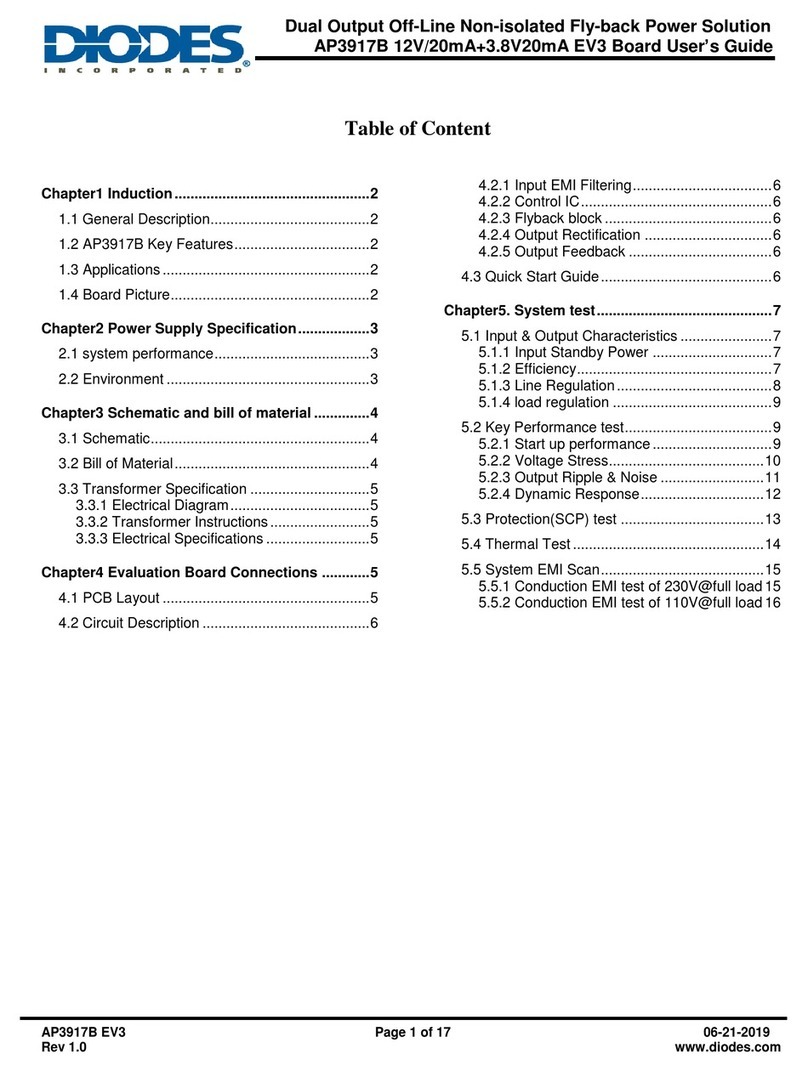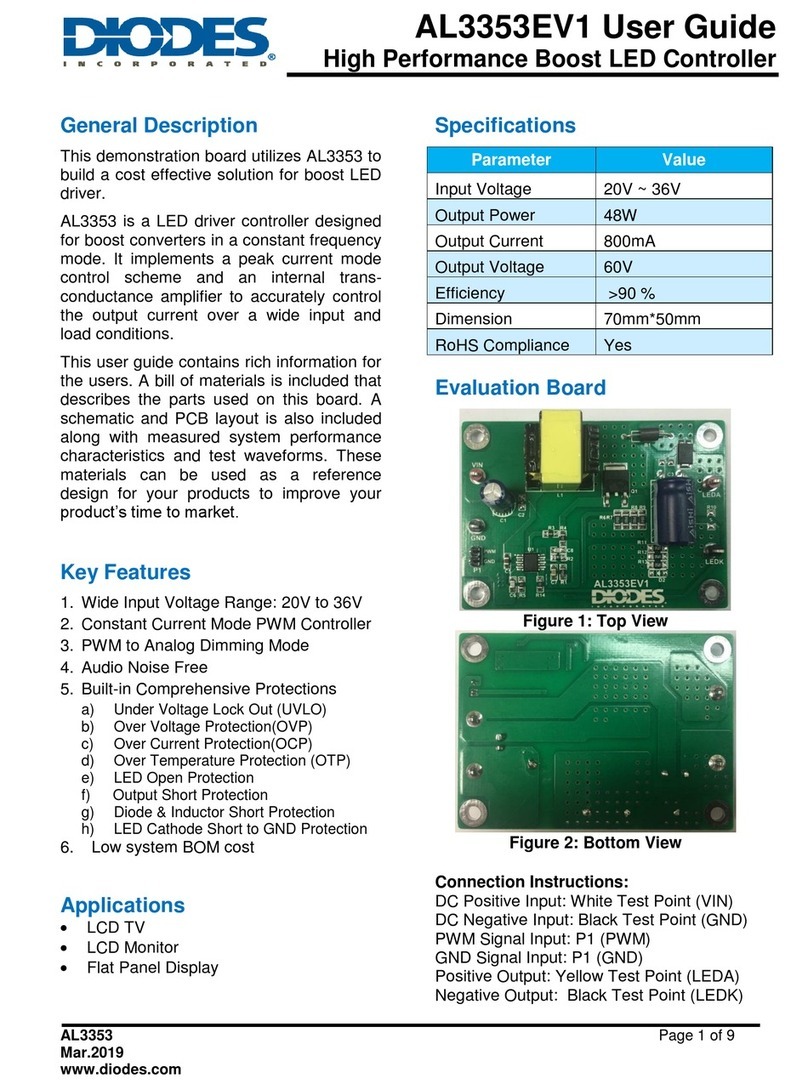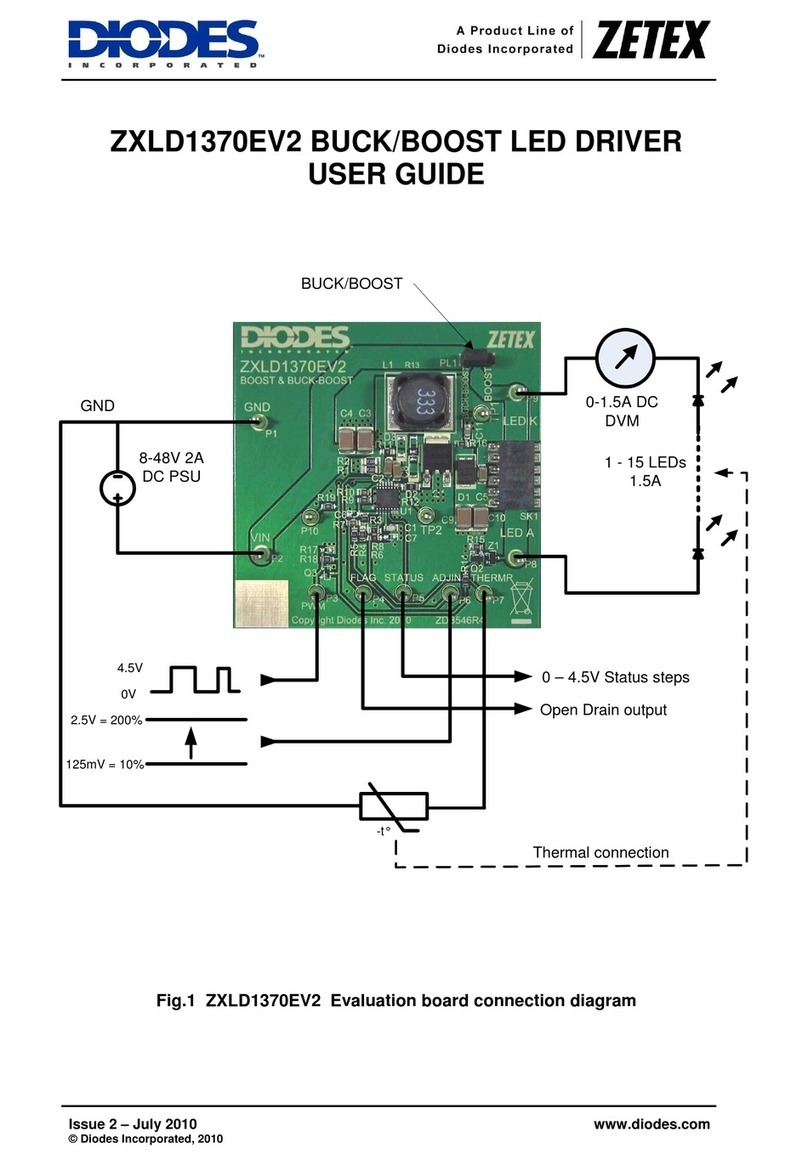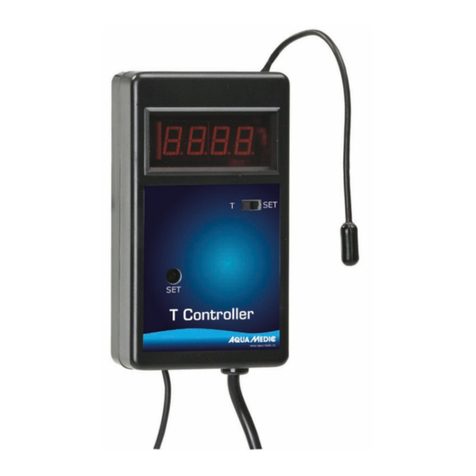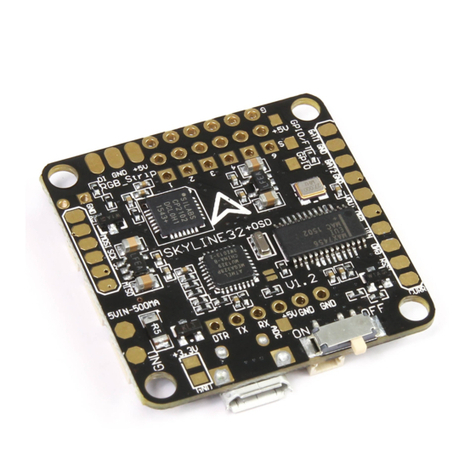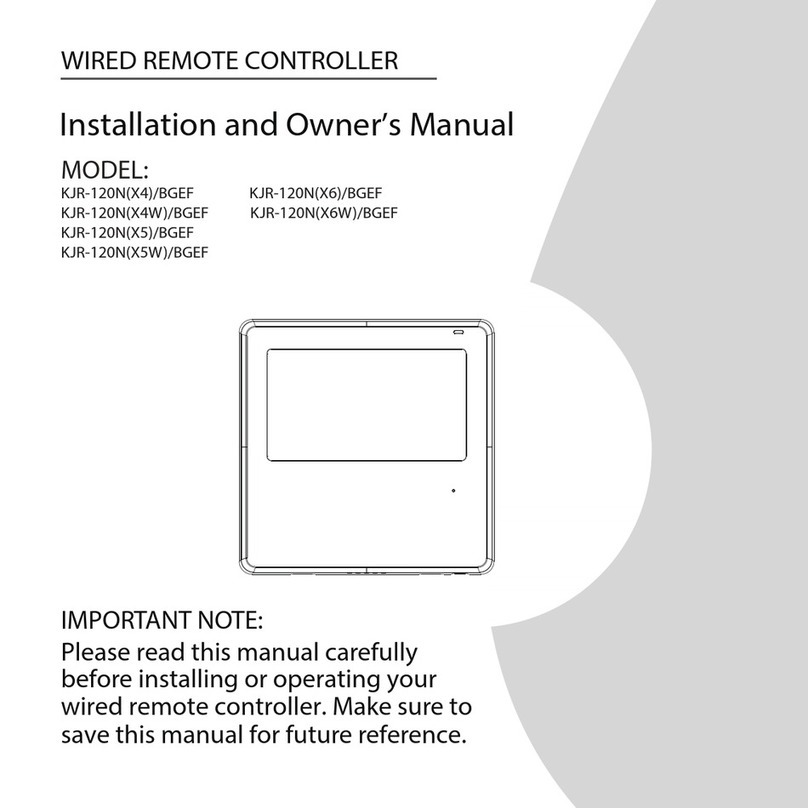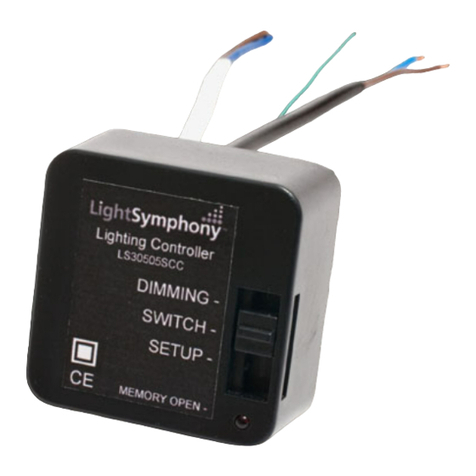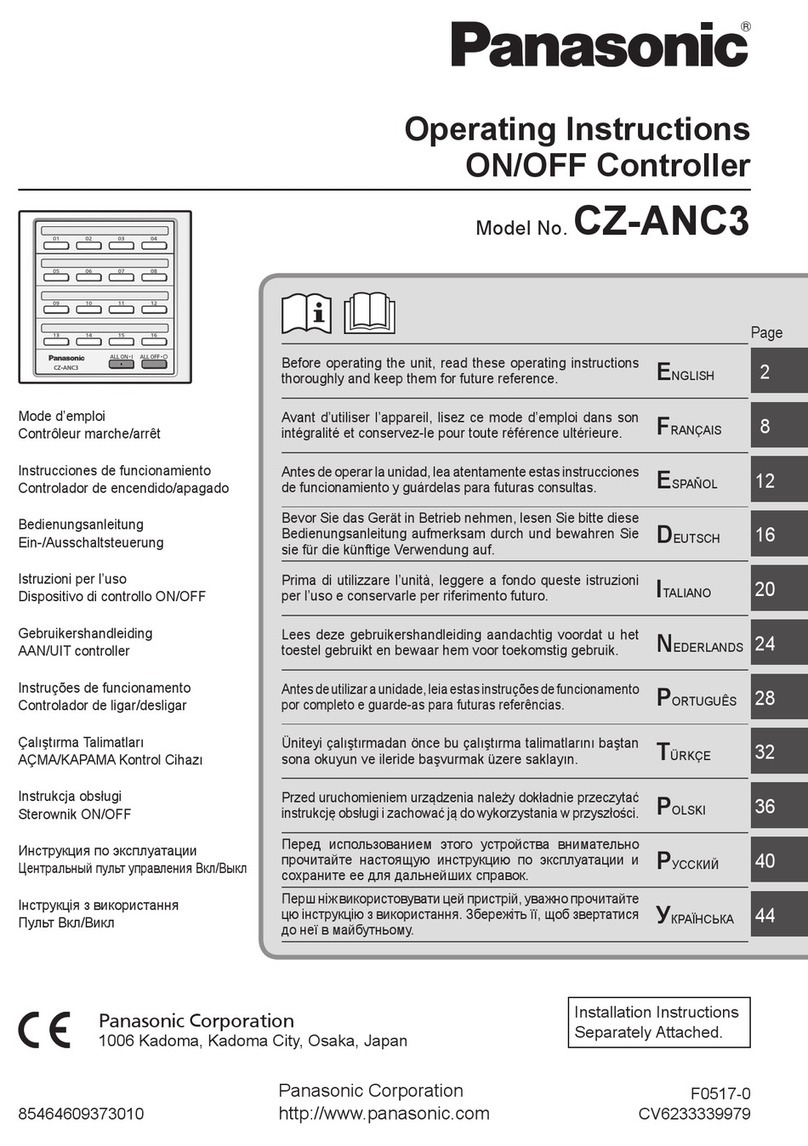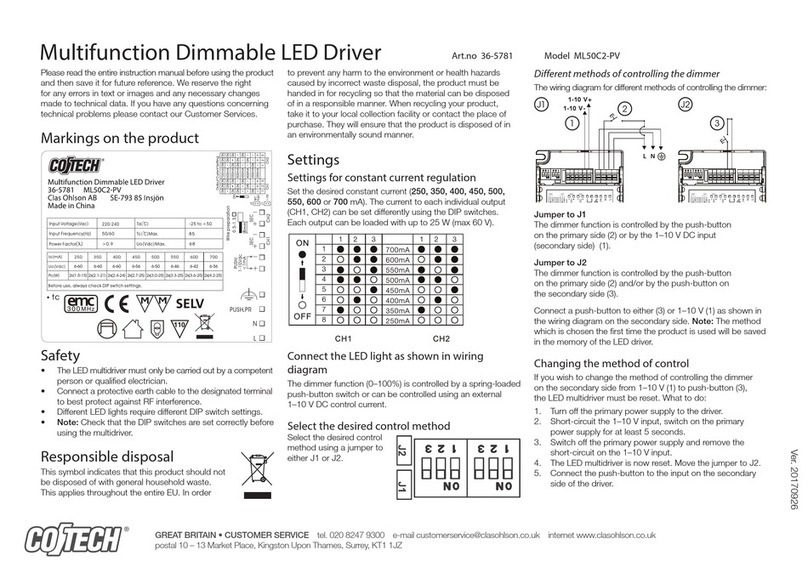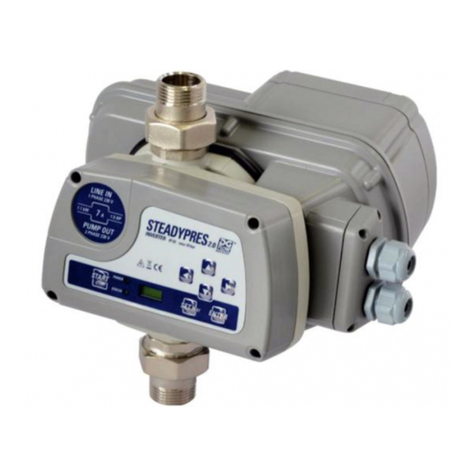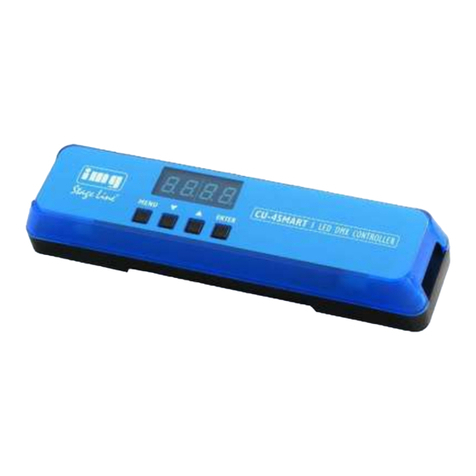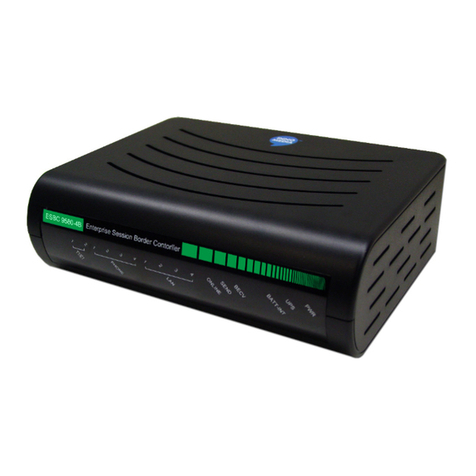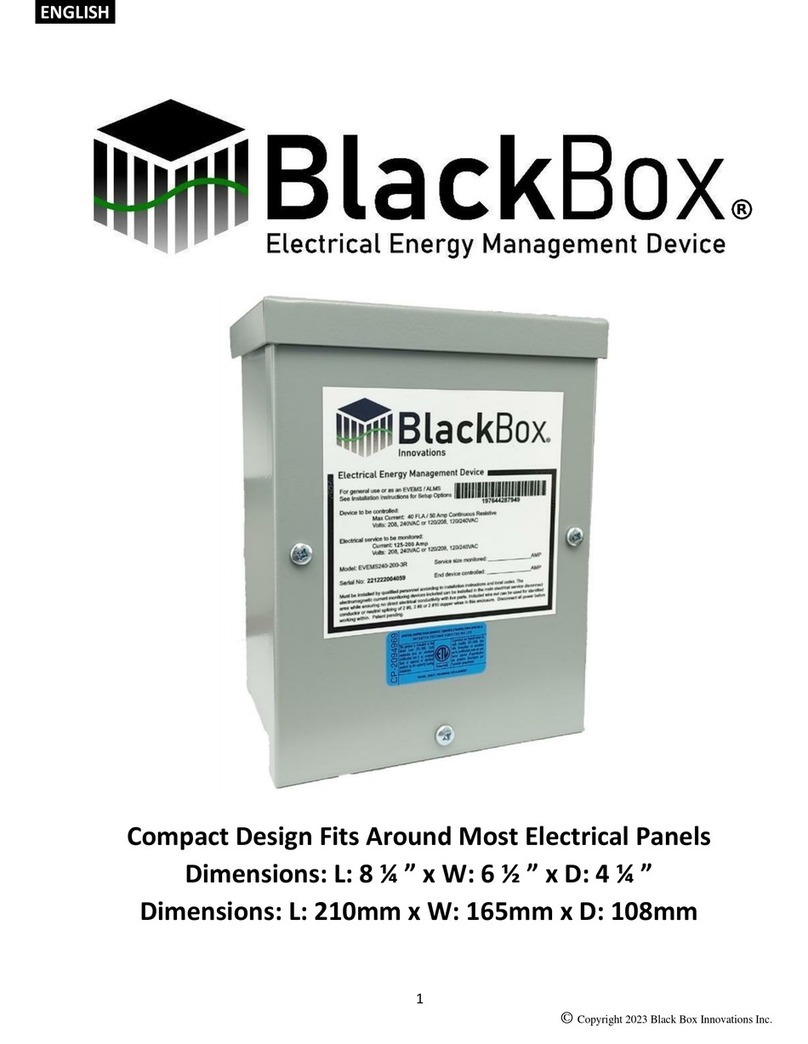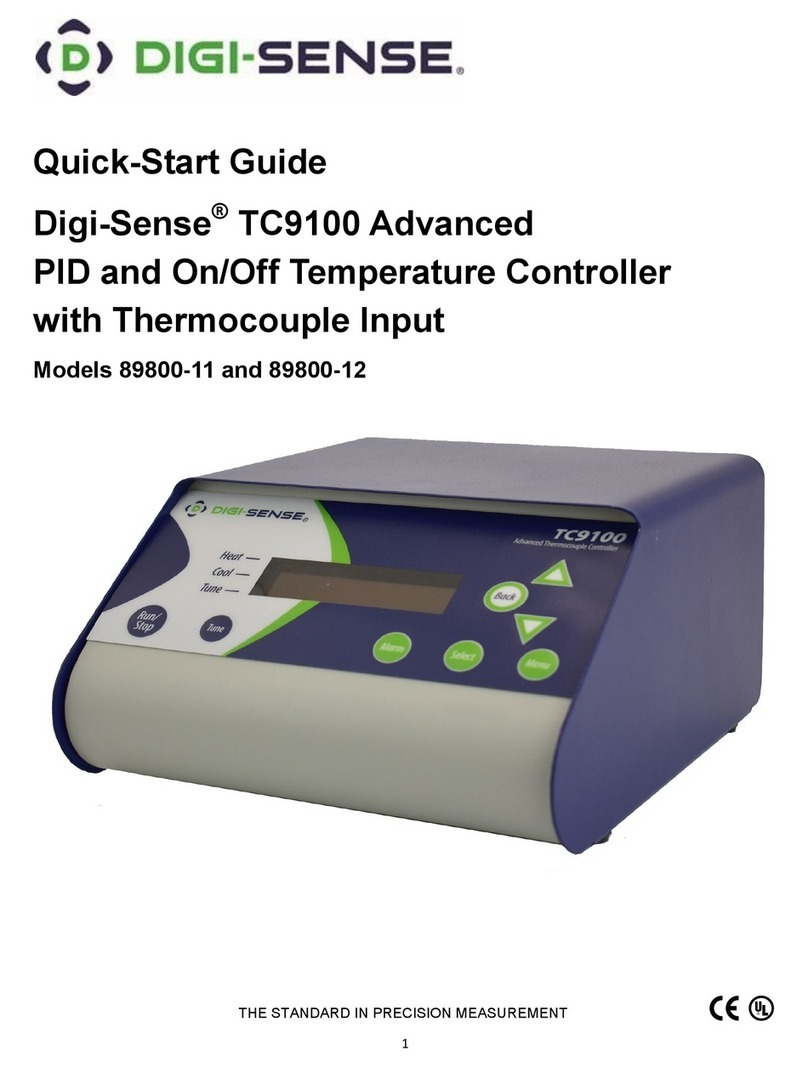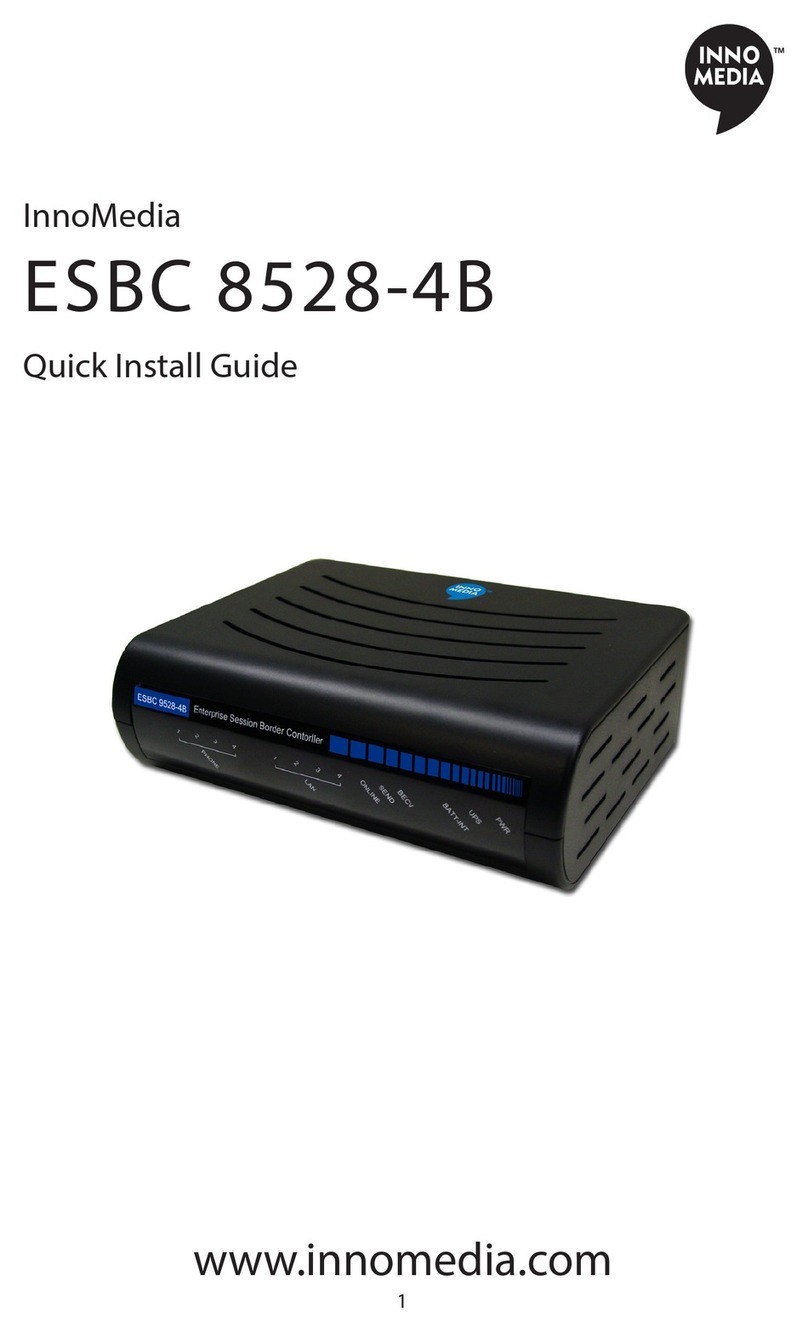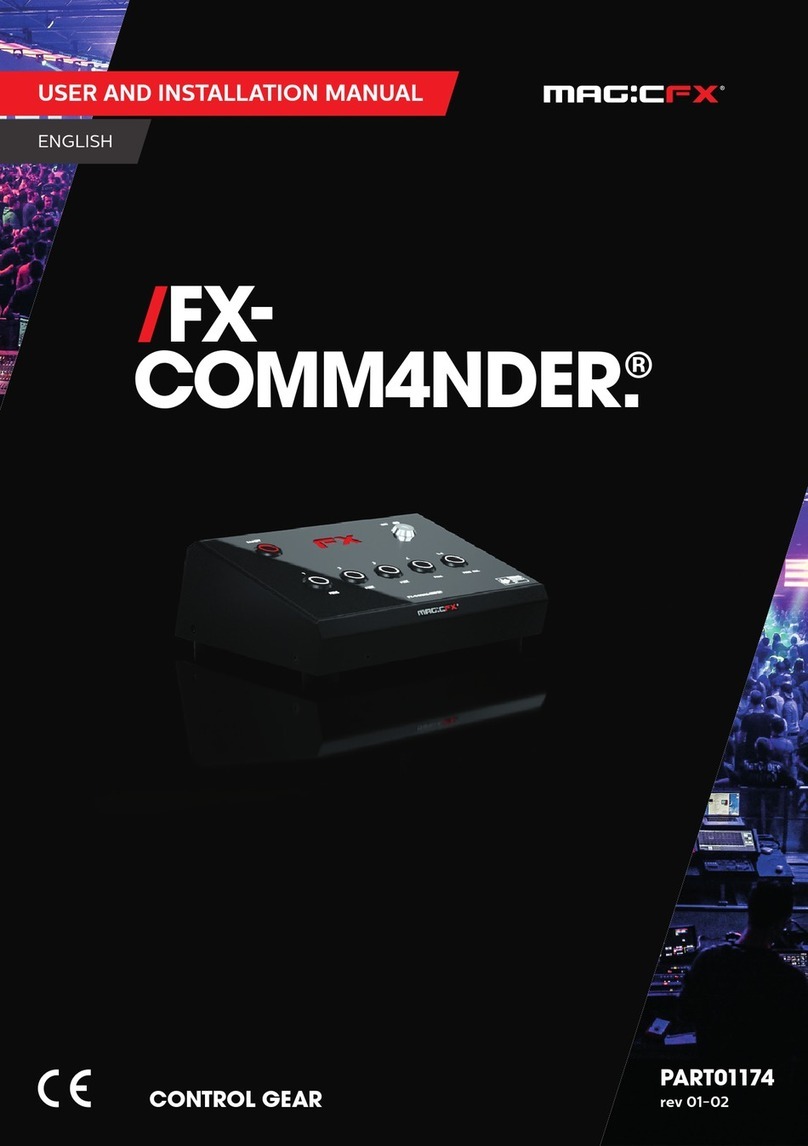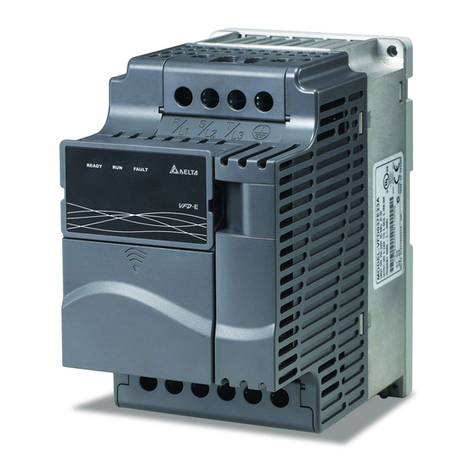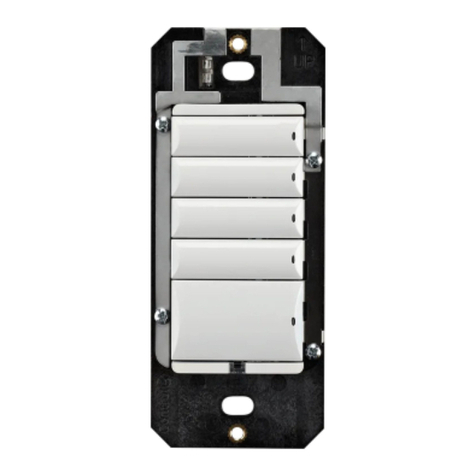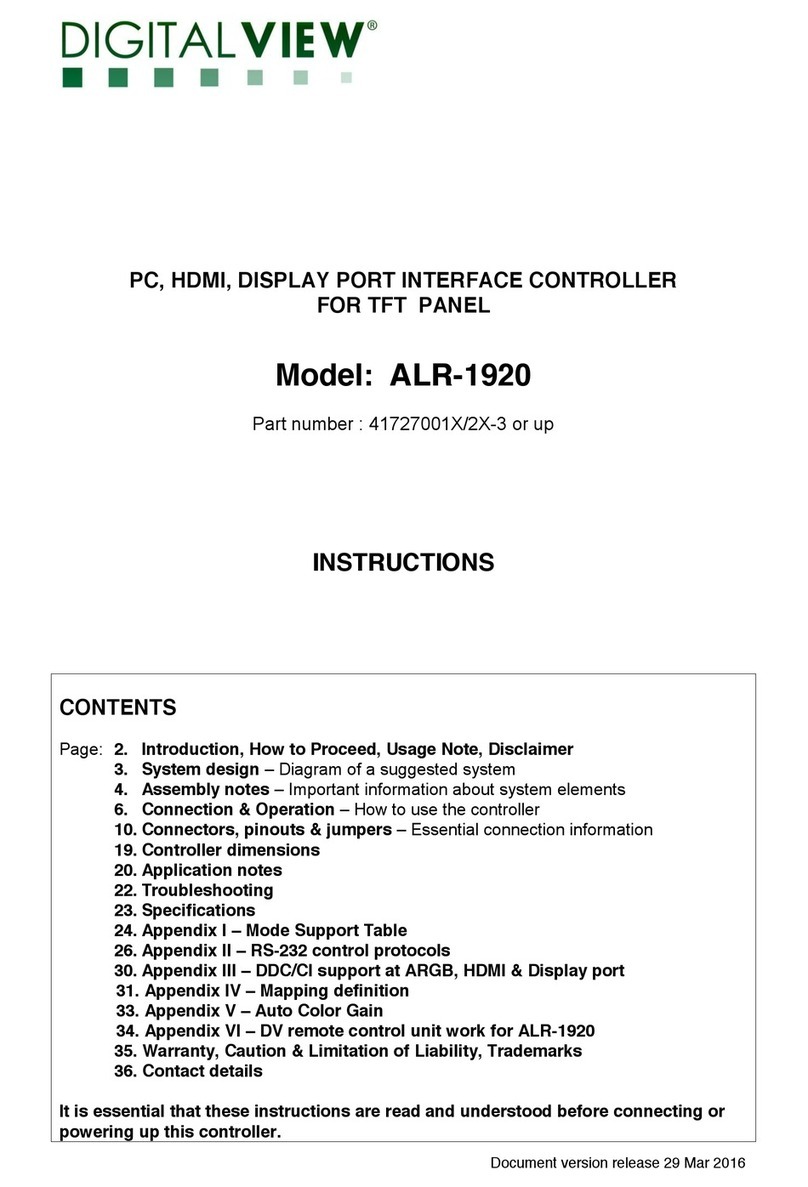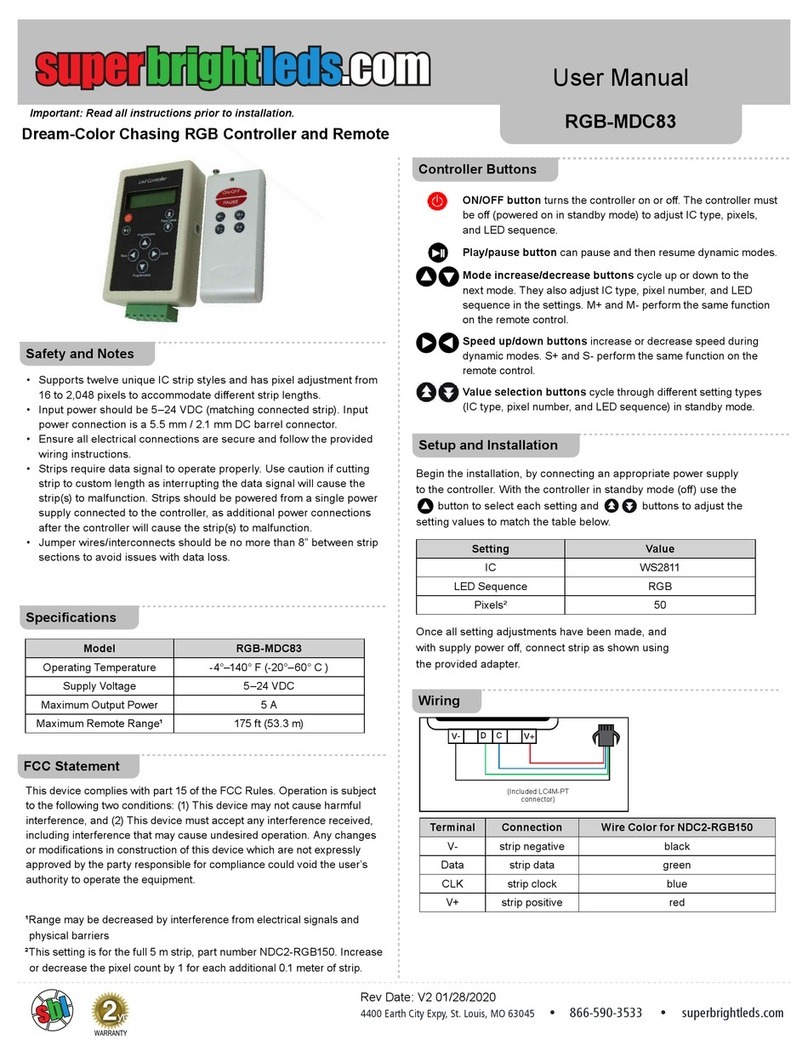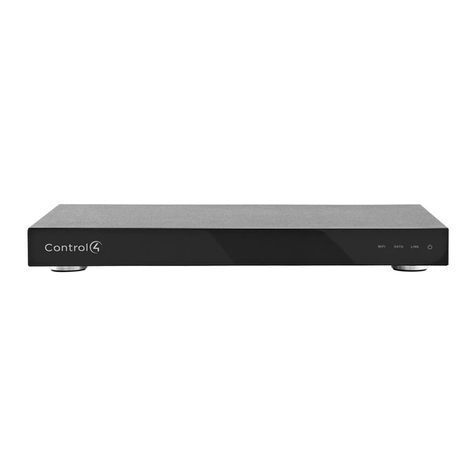Diodes AL5809QEV1 Series User manual

AL5809QEV1-XXX User Guide
15-150mA 60V Constant Current Regulator
AL5809QEV1-XXX Rev1 Page 1 of 11
September 2018
www.diodes.com
General Description
The AL5809Q is a two terminal constant
current linear LED driver and it provides a
cost-effective solution. It offers an
excellent temperature stability 20 ppm/⁰C
and the current accuracy ±5% regulated
over a wide voltage range. The AL5809Q
simplifies the design for linear LED drivers
allowing it to be designed as a high or low-
side constant current regulator without any
external components.
The AL5809Q turns on immediately and can
swing from 2.5V up to 60V enabling it drive
long LED chains. The floating ground, 60V
Voltage rating between Input and Output
pins designed to withstand the high peak
voltage incurred in DC and offline
applications.
The AL5809QEV1-XXX (from 15 to 150 mA)
is available in thermally robust POWERDI-
123 package with different current options,
please see ordering information section.
Key Features
Low Minimum Operating Voltage (2.5V
to 60V)
-40˚C to 125˚C Temperature Range
±5% LED Current Accuracy
PDI-123 package
Applications
Constant LED Current Driver
Isolated Offline LED Converters
LED Signs
Instrumentation Illumination
Specifications
Parameter
Value
Input Voltage
2.5V –60V
LED Current Options
15 to 150mA
XYZ Dimension
0.69”x 0.77”x 0.1”
ROHS Compliance
Yes
Top-View EVM (AL5809QEV1)
AL5809QEV1 (PDI123)
Bottom-View EVM (AL5809QEV1)
Connection Instructions
IN: Red Wire (LED connection)
OUT: Black Wire

AL5809QEV1-XXX User Guide
15-150mA 60V Constant Current Regulator
AL5809QEV1-XXX Rev1 Page 2 of 11
September 2018
www.diodes.com
Board Layout
(a) Top View
(b) Bottom View
Note: This evaluation board provides design flexibility, multiple application circuits can be
derived in both Low and High Side Current LED configurations. The footprint of U1 is compatible
to both of PDI-123 and SOD-123 packages. In addition, it can be hooked up with use of PWM
dimming.

AL5809QEV1-XXX User Guide
15-150mA 60V Constant Current Regulator
AL5809QEV1-XXX Rev1 Page 3 of 11
September 2018
www.diodes.com
Connection Setup and Power-up Procedures
Current LED String Procedure to Evaluation Board in Low side current LED configuration
Vcc (Power Supply)
External LED String
IN
OUT
XX Y W X
1
2
AL5809Q
IN Wire
OUT Wire
U1
1. Depends on the current options, the evaluation board is as low side current LED
configuration.
2. Ensure that the DC source is switched OFF or disconnected.
3. Connect the power supply to Anode terminal of external LED string in the Low side LED
configuration.
4. Connect the Cathode terminals of external LED string to IN terminal of the board and
connect OUT wire to GND.
5. Ensure that the area around the board is clear and safe, and preferably that the board and
LEDs are enclosed in a transparent safety cover.
6. Turn on the main switch. LED string should light up and the LED current should be regulated
according to the current options of the device.

AL5809QEV1-XXX User Guide
15-150mA 60V Constant Current Regulator
AL5809QEV1-XXX Rev1 Page 4 of 11
September 2018
www.diodes.com
Bill of Material
#
Name
Quantity
Part number
Manufacturer
Description
1
U1
1
AL5809Q-xxxP1-7
Diodes Inc
Constant Current Regulator in PDI123
Ordering Information
AL5809 - XXX Q P1 - XX
Packing
Package
7 : 7" Tape & Reel
P1 : PDI123
Current Option
15 : 15mA
20 : 20mA
25 : 25mA
30 : 30mA
40 : 40mA
50 : 50mA
60 : 60mA
90 : 90mA
100 : 100mA
120 : 120mA
150 : 150mA
Q : Automotive
Compliant
Qualification
Part Number
LED Current Option
Package
Identification Code
AL5809Q-15P1-7
15mA
PDI123
C1
AL5809Q-20P1-7
20mA
PDI123
C2
AL5809Q-25P1-7
25mA
PDI123
CA
AL5809Q-30P1-7
30mA
PDI123
C3
AL5809Q-40P1-7
40mA
PDI123
C4
AL5809Q-50P1-7
50mA
PDI123
C5
AL5809Q-60P1-7
60mA
PDI123
C6
AL5809Q-90P1-7
90mA
PDI123
C7

AL5809QEV1-XXX User Guide
15-150mA 60V Constant Current Regulator
AL5809QEV1-XXX Rev1 Page 5 of 11
September 2018
www.diodes.com
AL5809Q-100P1-7
100mA
PDI123
CB
AL5809Q-120P1-7
120mA
PDI123
C8
AL5809Q-150P1-7
150mA
PDI123
C9
Application Information
I) Current LED String Procedure in High side current LED configuration
ExternalLEDString
Vcc(PowerSupply)
IN
OUT
XXYWX
1
2
AL5809Q
INWire
OUTWire
U1
1. The evaluation can also be configured as High side current LED configuration.
2. Ensure that the DC source is switched OFF or disconnected.
3. Connect the power supply to IN terminal wire on the board.
4. Connect the Anode and Cathode terminals of external LED string between OUT terminal
and GND in the High side LED configuration.
5. Observe MAX 60V differential between IN and OUT terminals when applied Vcc > 60V.
6. In the high side circuit configuration, extreme high voltage may be present. Please use
caution and try not to touch any components on the board or input leads.
7. Turn on the main switch. LED string should light up and the LED current should be
regulated according to the current options of the device.

AL5809QEV1-XXX User Guide
15-150mA 60V Constant Current Regulator
AL5809QEV1-XXX Rev1 Page 6 of 11
September 2018
www.diodes.com
II) PWM Dimming
The AL5809Q can be used to provide LED current dimming driving the Out pin via the MOSFET
switch to ground. The Out pin current is then effectively switched on and off causing the LED
current to turn on and off
PWM_DIM
IN
OUT
XX Y W X
1
2
AL5809Q
C1=0.1uF/100V
Vcc (Power Supply)
IN Wire
OUT Wire
External LED String
U1
External LED String
Vcc (Power Supply)
IN
OUT
XX Y W X
1
2
AL5809Q
IN Wire
OUT Wire
C1=0.1uF/100V
U1
PWM ON/OFF
Switch
(a) PWM Dimming by External MOSFET (b) PWM Dimming by Power Supply VIN ON/OFF

AL5809QEV1-XXX User Guide
15-150mA 60V Constant Current Regulator
AL5809QEV1-XXX Rev1 Page 7 of 11
September 2018
www.diodes.com
1. The evaluation board can be configured as Low side current LED configuration with use
of PWM dimming.
2. Ensure that the DC source is switched OFF or disconnected.
3. Connect the power supply to Anode terminal of external LED string in the Low side LED
configuration.
4. Connect the Cathode terminals of external LED string to IN terminal of the board and
connect OUT wire to GND.
5. Insert external MOSFET across OUT terminal and GND of the board for PWM dimming
control.
6. Ensure that the area around the board is clear and safe, and preferably that the board
and LEDs are enclosed in a transparent safety cover.
7. Turn on the main switch. LED string should light up and the LED current should be
regulated according to the current options of the device.

AL5809QEV1-XXX User Guide
15-150mA 60V Constant Current Regulator
AL5809QEV1-XXX Rev1 Page 8 of 11
September 2018
www.diodes.com
Typical Performance Curves - 15mA, 20mA, 30mA, 40mA, and 50mA PDI123
0
10
20
30
40
50
60
0 5 10 15 20 25 30
LED Current [mA]
VInOut [V]
15mA
20mA
30mA
40mA
50mA
TA=25⁰C
Figure 1. LED Current vs. VInOut
Figure 3. LED Current vs. Ambient Temperature
Figure 5. THSD of 20mA Current Option
0
10
20
30
40
50
60
0 0.5 1 1.5 2 2.5 3
LED Current [mA]
VInOut [V], TA=25C
15mA
20mA
30mA
40mA
50mA
TA=25⁰C
VInOut[V]
Figure 2. Startup Minimum Operating Voltage
-10
-8
-6
-4
-2
0
2
4
6
8
10
0 5 10 15 20 25 30 35 40 45 50 55 60
LED Current Accuracy [%]
VInOut [V]
15mA_25C
15mA_125C
15mA_-40C
Figure 4 LED Current Accuracy (%) vs. VInOut across Temp
Figure 6. THSD of 40mA Current Option

AL5809QEV1-XXX User Guide
15-150mA 60V Constant Current Regulator
AL5809QEV1-XXX Rev1 Page 9 of 11
September 2018
www.diodes.com
Typical Performance Curves- 60mA, 90mA, and 150mA PDI123
Figure 7. LED Current vs. VInOut
VInOut=3.5
Temperature[⁰C]
Figure 9. LED Current vs. Ambient Temperature
Figure 11. THSD of 20mA Current Option
0
20
40
60
80
100
120
140
160
0 0.5 1 1.5 2 2.5 3
LED Current [mA]
VInOut [V]
60mA
90mA
150mA
TA=25⁰C
Figure 8. Startup Minimum Operating Voltage
Figure 10 LED Current Accuracy (%) vs. VInOut across
Temp
Figure 12. THSD of 40mA Current Option

AL5809QEV1-XXX User Guide
15-150mA 60V Constant Current Regulator
AL5809QEV1-XXX Rev1 Page 10 of 11
September 2018
www.diodes.com
Typical Performance Characteristics
0.00
0.25
0.50
0.75
1.00
1.25
1.50
025 50 75 100 125
Power Dissipation (W)
Ambient Temperature (°C)
Power Dissipation[W] vs. Ambient Temperature [⁰C]
for PDI-123,SOD-123on FR4, and PDI-123on Getek
SOD on FR4 (max Tj=145)
PDI on Getek (max Tj=145)
PDI on FR4 (max Tj=145)
Figure 13. Power Dissipation vs. Ambient Temperature @
TJ= 160⁰C
0
5
10
15
20
25
30
35
40
025 50 75 100 125
Maximum VInOut [V]
Ambient Temperature [°C]
Maximum VInOut [V] vs. Ambient Temperature [⁰C] for Current Option on PDI
FR4 Board (referred by Apps board FR4, 2-layer, 0.69"x0.76" size)
SOD on FR4 15mA
SOD on FR4 20mA
SOD on FR4 30mA
SOD on FR4 40mA
SOD on FR4 50mA
Figure 15. Maximum VInOut vs. Temperature
0
15
30
45
60
75
90
105
120
135
150
010 20 30 40 50 60 70 80 90 100
LED Current [mA]
Duty Cycle [%]
200Hz
500Hz
1KHz
1.5KHz
VInOut=3V, 150mA
Figure 17. PWM Dimming 150mA vs. Duty Cycle
0
10
20
30
40
50
60
025 50 75 100 125
Maximum VInOut [V]
Ambient Temperature [°C]
Maximum VInOut [V] vs. Ambient Temperature [⁰C] for Current Option on PDI FR4 Board
(refered by Apps board FR4, 2-layer, 0.69"x0.76" size)
PDI on FR4 15mA
PDI on FR4 20mA
PDI on FR4 50mA
PDI on FR4 90mA
PDI on FR4 150mA
PDI on FR4 40mA
PDI on FR4 60mA
Figure 14. Maximum VInOut vs. Temperature
Figure 16 PWM Dimming 90mA vs. Duty Cycle
0
1
2
3
4
5
6
7
8
9
0 0.5 1 1.5 2 2.5 3 3.5 4 4.5 5
LED Current [mA]
Duty Cycle [%]
200Hz
500Hz
1KHz
1.5KHz
VInOut=3V, 150mA
Figure 18. Area Zoom In within Duty Cycle 5% of Figure 17

AL5809QEV1-XXX User Guide
15-150mA 60V Constant Current Regulator
AL5809QEV1-XXX Rev1 Page 11 of 11
September 2018
www.diodes.com
IMPORTANT NOTICE
DIODE INCORPORATED MAKES NO WARRANTY OF ANY KIND, EXPRESS OR IMPLIED, WITH REGARDS TO THIS
DOCUMENT, INCLUDING, BUT NOT LIMITED TO, THE IMPLIED WARRANTIES OF MERCHANTABILITY AND FITNESS FOR A
PARTICULAR PURPOSE (AND THEIR EQUIVALENTS UNDER THE LAWS OF ANY JURISDICTION).
Diodes Incorporated and its subsidiaries reserve the right to make modifications, enhancements, improvements, corrections or other
changes without further notice to this document and any product described herein. Diodes Incorporated does not assume any
liability arising out of the application or use of this document or any product described herein; neither does Diodes Incorporated
convey any license under its patent or trademark rights, nor the rights of others. Any Customer or user of this document or products
described herein in such applications shall assume all risks of such use and will agree to hold Diodes Incorporated and all the
companies whose products are represented on Diodes Incorporated website, harmless against all damages.
Diodes Incorporated does not warrant or accept any liability whatsoever in respect of any products purchased through unauthorized
sales channel.
Should Customers purchase or use Diodes Incorporated products for any unintended or unauthorized application, Customers shall
indemnify and hold Diodes Incorporated and its representatives harmless against all claims, damages, expenses, and attorney fees
arising out of, directly or indirectly, any claim of personal injury or death associated with such unintended or unauthorized
application.
Products described herein may be covered by one or more United States, international or foreign patents pending. Product names
and markings noted herein may also be covered by one or more United States, international or foreign trademarks.
This document is written in English but may be translated into multiple languages for reference. Only the English version of this
document is the final and determinative format released by Diodes Incorporated.
LIFE SUPPORT
Diodes Incorporated products are specifically not authorized for use as critical components in life support devices or systems
without the express written approval of the Chief Executive Officer of Diodes Incorporated. As used herein:
A. Life support devices or systems are devices or systems which:
1. Are intended to implant into the body, or
2. Support or sustain life and whose failure to perform when properly used in accordance with instructions for use provided in
the labeling can be reasonably expected to result in significant injury to the user.
B. A critical component is any component in a life support device or system whose failure to perform can be reasonably expected
to cause the failure of the life support device or to affect its safety or effectiveness.
Customers represent that they have all necessary expertise in the safety and regulatory ramifications of their life support devices or
systems, and acknowledge and agree that they are solely responsible for all legal, regulatory and safety-related requirements
concerning their products and any use of Diodes Incorporated products in such safety-critical, life support devices or systems,
notwithstanding any devices- or systems-related information or support that may be provided by Diodes Incorporated. Further,
Customers must fully indemnify Diodes Incorporated and its representatives against any damages arising out of the use of Diodes
Incorporated products in such safety-critical, life support devices or systems.
Copyright © 2018, Diodes Incorporated
www.diodes.com
This manual suits for next models
11
Table of contents
Other Diodes Controllers manuals
